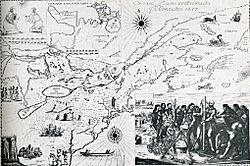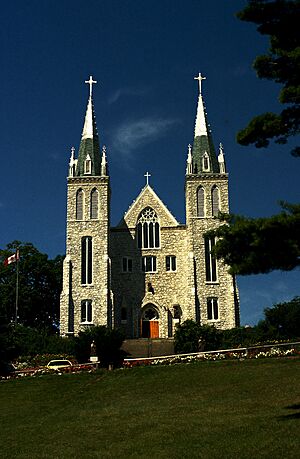Canadian Martyrs facts for kids
Quick facts for kids Canadian Martyrs |
|
|---|---|

Holy card depicting the martyrs
|
|
| Born | France |
| Died | 17th century, Canada and Upstate New York |
| Martyred by | Iroquois |
| Venerated in | Roman Catholic Church Anglican Church |
| Beatified | June 21, 1925, Rome, by Pope Pius XI |
| Canonized | June 29, 1930, Rome, by Pope Pius XI |
| Major shrine | Martyrs' Shrine, Midland, Ontario, Canada National Shrine of the North American Martyrs, Auriesville, New York |
| Feast | September 26 (in Canada and among Traditional Roman Catholics) October 19 (General Calendar); Anglican Church of Canada |
| Patronage | Canada |
The Canadian Martyrs (also known as the North American Martyrs) were eight Jesuit missionaries. They came from Sainte-Marie among the Hurons, a mission in New France. These brave men were killed in the mid-1600s. Their deaths happened in what is now southern Ontario and upstate New York. This was during a time of conflict between the Mohawk and Huron tribes. The Catholic Church later recognized them as martyrs and made them saints.
Here are the names of the eight martyrs:
| Name | Date of death | Place of death | Means of death |
|---|---|---|---|
| René Goupil | September 29, 1642 | Ossernenon, near Auriesville, New York | tomahawk to the head |
| Isaac Jogues | October 18, 1646 | Ossernenon, near Auriesville, New York | tomahawk to the head |
| Jean de Lalande | October 19, 1646 | Ossernenon, near Auriesville, New York | tomahawk to the head |
| Antoine Daniel | July 4, 1648 | Teanaostaye, near Hillsdale, Ontario | shot |
| Jean de Brébeuf | March 16, 1649 | St. Ignace, near Sainte-Marie among the Hurons, Ontario | boiling water and fire at the stake |
| Gabriel Lalemant | March 17, 1649 | St. Ignace, near Sainte-Marie among the Hurons, Ontario | boiling water and fire at the stake |
| Charles Garnier | December 7, 1649 | near Collingwood, Ontario | shot |
| Noël Chabanel | December 8, 1649 | Nottawasaga River, Ontario | tomahawk to the head |
Contents
Life of the Missionaries
Jesuit missionaries were priests who traveled to new lands. They worked among the Huron (also called Wendat) people. The Huron lived in the Georgian Bay area of Central Ontario. They were farmers, fishers, and traders. Their villages had strong wooden fences called palisades for protection. Sainte-Marie among the Hurons was the main base for the French Jesuit Mission.
By the late 1640s, the Jesuits felt they were making good progress. They said many Huron people had converted to Christianity. However, not all Huron trusted the priests. Some believed the missionaries brought bad luck or sickness. This was because many Huron had become very sick after Europeans arrived. Diseases like smallpox caused many deaths.
The Iroquois Confederacy was a group of powerful tribes. They saw the Jesuits as enemies. This was because the missionaries were allies of the Huron and French fur traders. The Iroquois also attacked the Huron and Jesuits to get back at the French. The French had attacked the Iroquois before.
The Martyrs' Deaths
In 1642, the Mohawk tribe captured René Goupil and Father Isaac Jogues. They took them to their village called Ossernenon. There, Goupil was killed. After several months, Jogues was rescued by Dutch traders. He went back to France for a while. Later, he returned to Quebec.
In 1646, Isaac Jogues and Jean de Lalande visited Ossernenon again. They hoped to make peace between the French and the Mohawk. But during this visit, both men were killed.
Other Jesuit missionaries also died in the following years:
- Antoine Daniel in 1648
- Jean de Brébeuf in 1649
- Noël Chabanel in 1649
- Charles Garnier in 1649
- Gabriel Lalemant in 1649
All these men were later made saints in 1930. They are known as the Canadian Martyrs.
Honouring the Martyrs
Pope Pius XI made the martyrs saints in 1930. They are considered the secondary patron saints of Canada. A patron saint is like a special protector. St. René Goupil, St. Isaac Jogues, and St. Jean de Lalande are also among the first saints from the United States.
Their special day, or feast day, is celebrated on October 19 in the United States. In Canada, it is celebrated on September 26.
The Martyrs' Shrine is in Midland, Ontario. This is where the Jesuits worked with the Huron people. It is a national shrine dedicated to the Canadian Martyrs. Another important place is the National Shrine of the North American Martyrs. It is in Auriesville, New York. This shrine is near a Jesuit cemetery. Missionaries who died in the area from 1669 to 1684 are buried there.
Places Named After Them
Many churches and schools are named after the Canadian Martyrs. This shows how important they are.
- The National Shrine of the North American Martyrs in Auriesville, New York.
- The Canadian national church in Rome, called Nostra Signora del Santissimo Sacramento e Santi Martiri Canadesi.
- Canadian Martyrs Parish in Calgary, AB.
- Canadian Martyrs Catholic Church in Ottawa, Ontario.
- North American Martyrs Parish and School in Monroeville, Pennsylvania.
- The Chapel of the North American Martyrs at Loyola University Chicago.
- Elementary schools in Newmarket, Ontario, Hamilton, Ontario, and Burlington, Ontario.
- Brebeuf Jesuit Preparatory School in Indianapolis, Indiana.
- Jesuit High School in Sacramento, California.
- Walsh Jesuit High School in Cuyahoga Falls, Ohio.
- Brebeuf College School in Toronto, named after St. Jean de Brébeuf.
A town in Quebec, Canada, is also named after them: Saints-Martyrs-Canadiens.
See also



